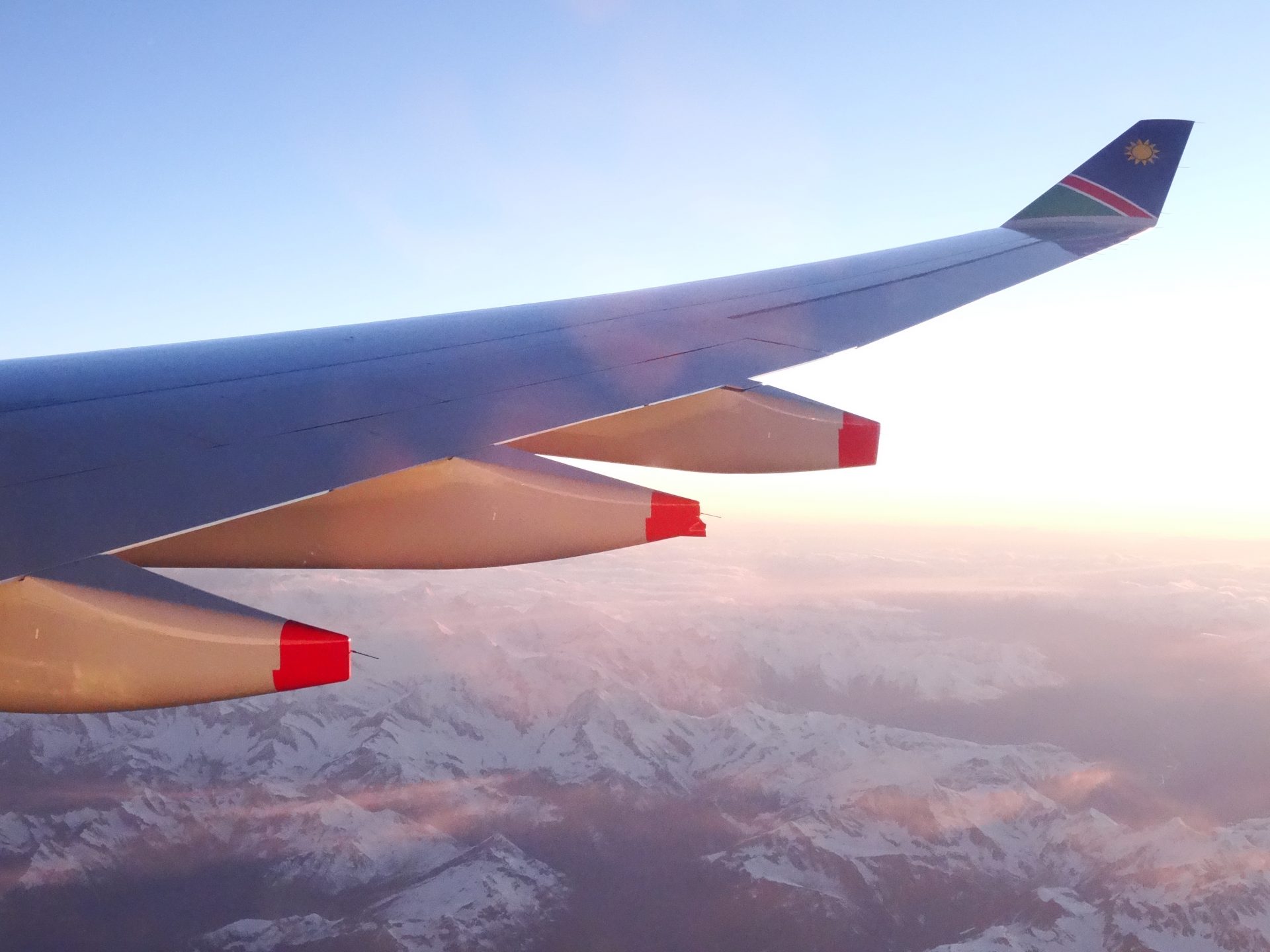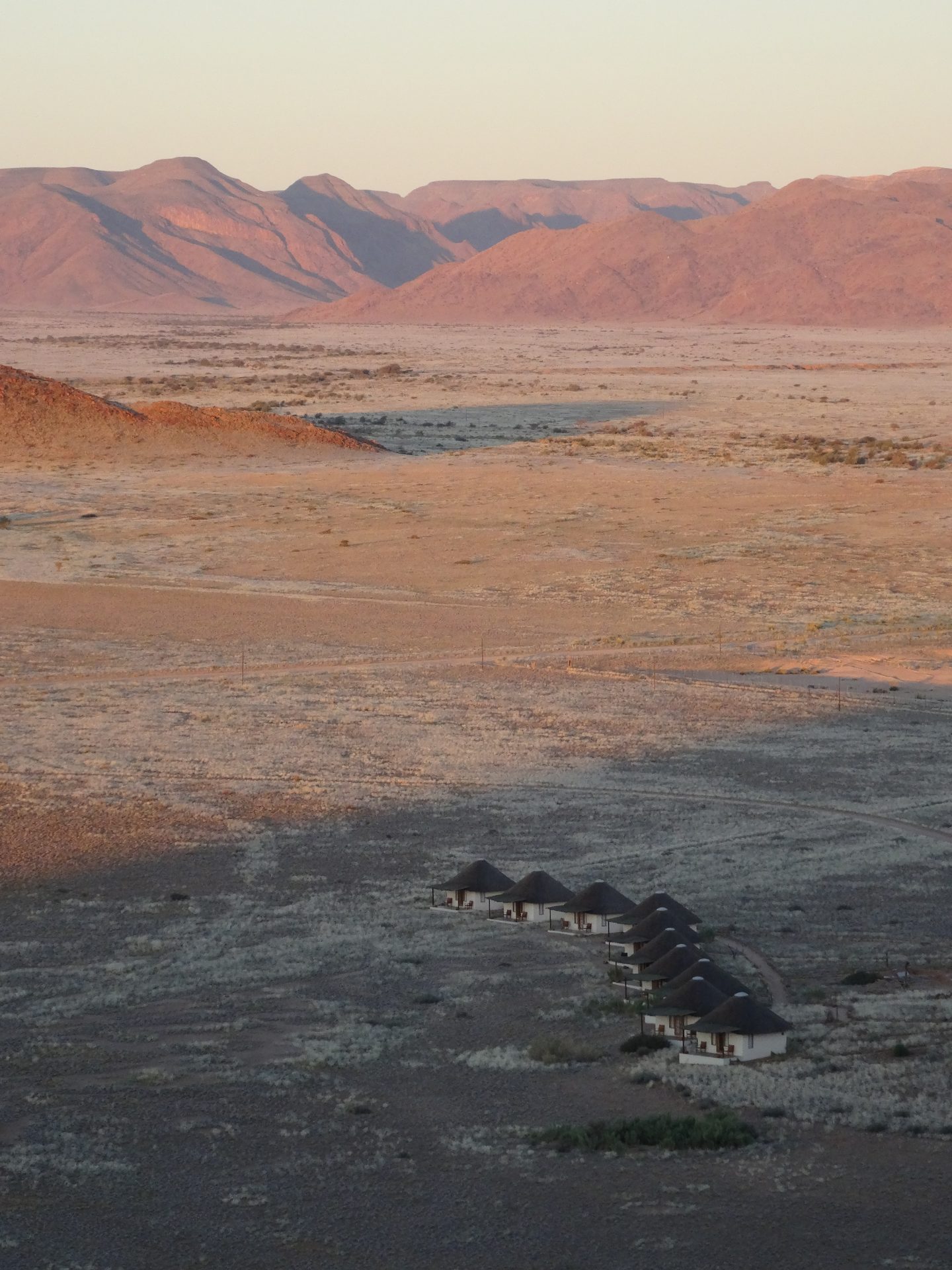This unforgettable trip is off to an unforgettable start, for all the wrong reasons. I had booked two return airline tickets to Namibia: British Airways to Frankfurt then onward with Air Namibia to Windhoek. The same in reverse eighteen days later. But the evening outbound connection in Frankfurt is very tight (about ninety minutes) so I’ve booked a morning BA flight to Frankfurt – we can relax. We’re at Heathrow Terminal 4, we’ve just checked in, and our bags have disappeared down the conveyor belt. In passing, I mention to the check-in agent that we’ve got two tickets for a later BA flight to Frankfurt that we won’t be using. She looks at me and frowns. “I’m sorry but you’ve got a problem. If you skip a segment on a multiple flight itinerary the remainder of your ticket will be invalid. In other words, if you don’t take your later BA flight to Frankfurt, the one you originally booked, then your onward flight to Namibia will be cancelled, as will all your return flights”. I try to remain calm. “But I’ve just checked into this earlier flight and our baggage has gone”. She reassures me. “I can reverse that and retrieve your bags. In about seven hours you can check in for your original Frankfurt flight”.

Jo’s Now Famous No Hairdryer Required Namibian Hairstyle
Great! So that’s how we start our great African safari – nine hours in Heathrow Terminal 4. And it doesn’t get any better. French Air Traffic Control is on strike (again!) and our departure is delayed by an hour. Our window to connect to our Air Namibia flight is now just 30 minutes. Frankfurt International Airport is huge – there’s no way we’re going to make it. Having landed in Germany, as we’re taxiing to our gate we pass an Air Namibia Airbus A330 – our flight! Ten gates further on we dock and we’re first off. Our connecting flight was due to depart about fifteen minutes ago. I tell Jo, “As soon as you get off the air bridge, turn right and run like hell. Don’t let that Air Namibia flight leave without us. I’ll be right behind you”. She’s fast and I’m not right behind her at all, but I can see her up ahead waving our boarding passes in the air. We make it. At the airplane door we’re greeted by a big friendly African steward. Remarkably he tells us that they were expecting us. Everybody is strapped in and the plane is prepared for takeoff. We feel exposed, dark stares from some passengers. Like them, I have in the past looked at late boarders and thought, “selfish idiots, holding up the entire flight”. I ask the steward about the chances of our baggage getting onboard. He walks up to the galley and looks out of a window. A few minutes pass, he looks out of the window again, then he turns to me and, with a huge grin he gives me a thumbs up with both hands. After all the anxiety, this is brilliant. Almost immediately, we’re rolling back.


Day 1
It’s 5.30am the next morning, and with only a two hour difference between Windhoek and London, we don’t experience any jet lag. We land in brightly sunlit Windhoek, the capital and biggest city in Namibia, but it’s not big with a population of less than half a million people.
Namibia in a nutshell: the driest country in Sub-Saharan Africa it was formerly known as German South West Africa. The country was populated for thousands of years by San (Bushmen) hunter gatherers, who were gradually displaced by African Bantu tribes from the north and ultimately by European colonists. Brutal German rule ended, during the first world war, in 1915, with occupation by South African forces. In 1920, after the end of World War I, administration of the colony transferred to South Africa which imposed its laws, including racial classification which ultimately included apartheid. Renamed Namibia in 1968 it obtained full democratic independence from South Africa in 1990. The large, arid Namib Desert, the oldest desert in the world, from which the country derives its name, has resulted in Namibia being one of the least densely populated countries in the world, only Mongolia is less dense. 2.6 million people live in Namibia – about 0.5% of the UK population, and it’s four times the size of Great Britain, so very sparsely populated.

With more than 300 days of sunshine per year, it is situated at the southern edge of the tropics. The Tropic of Capricorn cuts the country about in half. The winter (June – August) is generally dry. Both rainy seasons occur in summer: the small rainy season between September and November, the big one between February and April. We are here in May, the rains have stopped, but the scenery is still lovely and green. The nights aren’t cold, and days are always sunny with temperatures around 24-28°C, not too hot – comfortable enough for activities, and travel and sleeping. We have a supply of antimalarial drugs but we won’t be bothered by mosquitoes. For some strange reason, May is not hugely popular with tourists, which suits us fine.
I visited the country for a long weekend break in 1988. I was living in Johannesburg, South Africa at the time and flew into Windhoek and on to Swakopmund on the wild Skeleton Coast. I was fascinated by the country and pledged that one day I would return – a pledge now being fulfilled.

We linger in the arrivals hall for a couple of hours before meeting our Drive South Africa rep for a short drive to their rental depot, a big shed on the airport perimeter road. It’s full of camper vans, Land Rovers and pickup 4X4s, tents, jerry cans, wheels, ropes, batteries and assorted camping equipment. We’ve hired a white Nissan Trax STX 4X4 Camper, basically a pickup with a big box on the back with a pop-out side facilitating a double bed and pop-up roof. Inside is a fridge and a decent sized freezer. The gas cooker and sink are outside the vehicle, sliding out to the side. There are two diesel jerry cans strapped on the back and spare calor gas cylinders strapped at the front. Inside, the van is bathed in an unworldly blue light. It is what I imagine a small spacecraft to be like, and whilst it is nowhere near as small as the Soviet Sputnik satellite, that’s what I name it – Sputnik.

Along a wall of the Drive South Africa shed is a collage of graphic photographs of injured passengers, and damaged or wrecked 4X4s. These are surrounded by notices offering the following advice:
Drive on the left.
Distances are vast, even longer when you account for the gravel/sandy roads which you’re likely to encounter so add an hour or two to your planned journey time.
Namibian roads are long and empty so it can be tempting to speed. Don’t!. Stick to the road rules. Gravel roads (‘D’ or ‘C’ prefixes on maps) offer poor traction at speed and can turn to sand very quickly which can result in accidents. If you’re unlucky enough to have an accident, it may be hours/days until someone finds you, and if you’re severely injured, medical help may be hours away.
Watch out for animals. Unsurprisingly, Namibia is full of them, often in the least expected places.
Do not drive at dusk. Animals are far more lively at this time of day, while in some areas where road lamps are not common, people walk home on the shoulder of the road and are almost impossible to see. If you do drive at dusk or evening, use your high beams and drive slower than the speed limit. Never drive at night.
Don’t get lost. Buy a decent map – do not rely on Google. Speak with the locals to confirm your route.
Fill up with fuel at every gas station you pass. Don’t get low on fuel with reliance on a gas station that may be closed or one that doesn’t have any fuel. And always tip the gas station attendant.
If you’re heading off-road, pack extra supplies including food, water, and warm clothing. It’s recommended to take a minimum of 10 litres of water and enough food to last 2-3 days if the need arises.
Punctures are always a possibility, especially on gravel roads, and speed may increase their likelihood. Learn how to change a tyre before you depart.
Give lots of clearance to vehicles on gravel roads when overtaking and keep long distances between yourself and any vehicle in front of you. The sand can be blinding and the kicked up gravel can damage your vehicle and windscreen.

We’ve spent many hours planning our itinerary. We have Accommodation Vouchers for dates at campsites and lodges and we’ve checked that our distances and timings make sense with a very helpful agent at Namibia Reservations. We check the contents of the van with our vehicle inventory checklist, sign the paperwork and get the keys. First stop will be Pick n Pay – one of Southern Africa’s biggest supermarket chains. Two hours later, we’re fully stocked and on the road south to Sesriem in the Namib Desert.
This is a road trip with overnight camping in the vehicle, but we’re not going to be roughing it like Livingstone all the time. There are many comfortable, often luxurious lodges in Namibia and, over the next 17 days, we’ll be staying at five of them. To recover from the journey we’ll spend our first couple of nights at Desert Homestead Lodge , a row of twenty thatched chalets, sheltered by mountains and with views of the distant dunes of the Namib Desert in the west. It’s 2.30pm in Windhoek and the sun sets sharp at 6.20pm. It’s just over 4 hours to Sesriem on gravel roads. The rule is ‘Don’t speed and don’t drive in the dark’, our first challenge. Gravel roads are susceptible to a phenomenon called washboarding or corrugation, the formation of periodic, transverse ripples on the surface of the road. It makes for a very uncomfortable bumpy ride, but if you get your speed right (about 60mph), the bumping is minimised. But drive too fast and you can lose traction. So there’s no point rushing – we’ll get there when we get there……..which is just after dark. Tomorrow we will drive into the desert.
